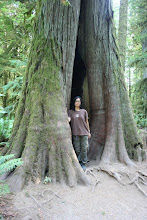Our professor showed us the video in class, but he didn't really go through this phylum. I found the video accidentially (thanks for YouTube) when I was searching information regarding how Onychophorans feed. People call them "water bears", and you will know why they are given such a cute name when you see how they walk.
This animal is tiny, usually no bigger than a few mm, but they can be found in the most extreme environments on earth. Below are some introductory information on Tradigrada taken from Wikipedia:
Tardigrades (commonly known as water bears) comprise the phylum Tardigrada. They are small, segmented animals, similar and probably related to the arthropods. Tardigrades were first described by Johann August Ephraim Goeze in 1773 (kleiner Wasserbär = little water bear). The name Tardigrada means "slow walker" and was given by Spallanzani in 1777. The biggest adults may reach a body length of 1.5 mm, the smallest below 0.1 mm. Freshly hatched larvae may be smaller than 0.05 mm.
More than 1000 species of tardigrades have been described. Tardigrades occur over the whole world, from the high Himalayas (above 6,000 m), to the deep sea (below 4,000 m) and from the polar regions to the equator.
The most convenient place to find tardigrades is on lichens and mosses. Other environments are dunes, beaches, soil and marine or freshwater sediments, where they may occur quite frequently (up to 25,000 animals per litre). Tardigrades often can be found by soaking a piece of moss in spring water.[3]
Water bears are able to survive in extreme environments that would kill almost any other animal. They can survive temperatures close to absolute zero[4], temperatures as high as 151°C (303°F), 1,000 times more radiation than any animal[5], nearly a decade without water, and can also survive in a vacuum like that found in space. Infact, because of its ability to survive the most extreme conditions, The Most Extreme made it a number 1 contestant on "the living dead".
Friday, April 04, 2008
Subscribe to:
Post Comments (Atom)



No comments:
Post a Comment